
What to look for at your next property inspection
August 31, 2018 - Blog
I’ve always found it interesting that people decide to buy a home after usually only spending a few minutes at a property inspection.
Sure, they might go back one or two more times to solidify their love for the property, but often their decision-making is based solely on how they feel about it.
Even a poor building and pest report might not be enough to dissuade them from pushing forward with their decision.
When buying as an investor, emotion should be kept to a minimum when purchasing property.
What matters most is whether that property fits with your investment strategy and whether it is everything that it seems.
As well as being a property investment adviser and buyer’s agent, I am a qualified architectural engineer and when it comes to property inspections I have an eye for what’s right and what is clearly not.
What do I look for at a property inspection?
At the initial property inspection, I use a checklist to take note of features, defects, positives and negatives of the property on a room by room basis, as well as taking photos, with the outcome communicated to my client afterwards.
On the second inspection, I query any issues with the agent, as well as conduct a more detailed inspection including checking for any cover-ups that may have been done just for the sale – especially bad paint jobs!
I also look for:
• Uneven/unstable floors
• Unsafe decks
• Concrete spalling
• Damp on the bottom of external walls and internal walls behind showers
• Musty smells
• Cracks in walls and floors
• Large trees
• Roof damage.
I try to test everything, such as water pressure and hot water; check to see that the windows and doors open properly; and turn on lights and fixtures.
I even ask the selling agent to provide confirmation in writing that everything is working in the property.
What are some of the most common building faults?
There are a number of issues which can cause headaches for new owners and that’s why knowing what to look for is so critical.
Some of the most common building faults include:
1. Water/damp issues – from poor drainage externally (gutters, downpipes, stormwater), damp subfloor, plumbing leaks internally, roof damage, waterproofing issues, insufficient ventilation.
2. Structural defects – a build-up of the above can cause damage to roof members, foundation walls and floor joists. Large trees with extensive roots can cause damage to drains, footings and slabs.
3. Safety issues – unsafe decks, balconies and balustrades/pool fencing. No electrical safety switches. Presence of asbestos. No smoke alarms or insufficient alarms.
4. Poor quality renovations and illegal additions.
5. Pest infestation – caused by poor maintenance and damp conditions.
6. Termites – about 30 per cent of freestanding homes have had some instance of termite activity, which is why it’s imperative to pay for a professional pest inspection.
One of the many great things about Australia is that we have a wide variety of architectural styles, but that also means there are different defects you need to look out for.
For example, Victorian terraces are prone to poor drainage, rising damp and ventilation issues, whilst other older homes often have sagging ceilings from heavy plaster linings with insufficient fixings as well as timber stumps that are prone to rotting.
It’s not so romantic to own an old home that is leaking, or subsiding, is it!
Of course, this is where professional guidance can help you identify any issues that are not immediately apparent to the untrained eye.
What about vendor property inspection reports?
Inspection reports are often provided by vendors but that doesn’t mean that buyers should rely on that information exclusively.
Depending on the quality of the building report, I usually recommend clients engage their own inspector to ensure independence.
Of course, it is always the buyer’s decision whether to proceed with the purchase, but by working with a professional, buyers have all of the information they need to make an informed decision about the risks of proceeding – especially if the property has any defects.
Successful property buying comes down to multiple factors, including strategy, location and asset selection, but it’s also about ensuring that you don’t buy a dud that’s been dressed up to the nines!
If you’re looking to get help with your next property purchase and would like advice from a qualified property professional, then please get in touch with STRAND Property Group today:


